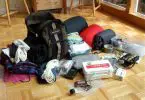When you’re out and about in the Great Outdoors, it’s far too easy for small issues to turn into major problems; for instance, your walking boots break, it rains torrentially and your coat just doesn’t hold up to the weather pelting down on you, or it could be that the zipper decides to break on your coat or your tent, and you’re left with a coat which doesn’t keep you quite warm enough at best, and a tent that isn’t secure or warm, at worst.
See also: Sleeping Bag Zipper Repair: Skip the Professional and Do It Yourself
Zippers can be a major problem, but if you can find out how to fix one in the event of a problem, no issue! There are many things which could go wrong with a zipper; it’s not just a case of it breaking or getting stuck, so you need to be somewhat of an expert.
What Can go Wrong With a Zipper?
The zipper can get stuck
This could be because of twisted teeth in the zipper itself, which causes a complete halt on movement, or it could be because it got stuck in the material to either side. Whatever happens, if your zipper gets stuck you’re going to need to be careful how you un stick it – brute force is likely to cause more harm than good!
The zipper can become separated from each side
This has no doubt happened to you at some point in the past; perhaps when you were at school and your school bag decided to break at a very inopportune moment, or maybe it was your coat again. Whatever situation this was in, a separated zipper needs care and attention, if you’re going to avoid having to replace it completely.
Bent teeth on the zipper
Again, this is going to stop the zipper from moving completely, so you will need to learn how to realign and straighten the teeth to allow the carriage of the zipper to move freely once more.
The zipper basically needs to be replaced
Sometimes you can’t save your zipper, no matter how hard you try, and in that case you need to learn how to fit and replace a zipper properly, to avoid future issues. How to get a zipper back on is a common question, but thankfully it’s not overly difficult.
Zipper Issues And How to Fix Them
We’ve mentioned that in order to know how to fix a broken zipper, you need to know what exactly can go wrong with one, but once you know what is wrong, you’re in a better position to actually fix the problem properly. Let’s check out a few common situations and explain how to fix a broken zipper properly.
Stuck Zippers
There are a few ways you can unstick a zipper, but most methods require lubrication of some kind, because as we mentioned before, brute force alone is not going to do the zipper much good, and will probably end up breaking it completely, or causing another problem, such as bent teeth on the zipper itself. You can use graphite, laundry soap, or even something like Vaseline, but you basically need to encourage movement.
First things first – why is it stuck? Is there something blocking it? If so, you need to try and clean it out, and you can do that by using a cotton bud stick or something similar; if it’s really stuck, try using tweezers, to dislodge whatever is causing the blockage.
Now the blockage has gone, the zipper may decide to move freely, but if not, you need to try and encourage it a little more. This is where the lubrication side of things will come in very handy, because once lubricated, you’ll probably find that the zipper moves.
Graphite is found in pencils, usually the number 2 variety, and it is useful in zipper fixing because there is a natural grease in its make up. If you rub this graphite onto the zipper, particularly where the ‘stuck part’ is and then gently try and move it, you will probably find it moves, if not repeat the process and try a few more times.
You might find that you need to wiggle it a little, but don’t push too hard, as you’ll end up causing damage which may or may not be fixable. Laundry soap can be used in exactly the same way, however in order to apply it it’s best to dip a cotton wool ball into the soap and then run it under a little water, to dilute it slightly.
Make sure the cotton wool ball is totally coated and then repeat what we talked about when using graphite. You will probably need to repeat this process a few times until the zipper unsticks completely and moves freely.
Separated zippers
A separated zipper happens because there is too much pressure being put on the zip, so perhaps your jacket is too tight, and in that case, sorry to say it, but you need a bigger size, or you need to wear less clothes underneath it.
A separated zipper may right itself when there is less pressure on it, but only if the separation is slight and not too much. If the zipper has gone over the point of no return, you’re best to remove it and replace with a new zipper entirely.
This isn’t an issue which should really happen to tent zippers, until you are pulling the tag on the zipper too hard when opening or closing, so simply go carefully to avoid these problems from occurring in the first place.
Bent Teeth Inside The Zipper
Bent teeth will obviously stop the zipper from moving completely, because there isn’t a smooth track for the carriage to work with. In order to straighten bent teeth, all you really need is a pair of tweezers.
Find out where the bent teeth are, and then using the tweezers, try and straighten them – go carefully however, because if you snap the teeth which are bent, there is no going back. Having said that, zippers on outdoorsy equipment is a lot more hard-wearing than your average school bag, so a little extra pressure isn’t going to cause the biggest issue here.
As you’re attempting to straighten the teeth, keep testing by moving the carriage gently to the point where the bend is, and wiggle it a little; you may never have a clear passage past that point in the future, because the teeth in this area are never going to be 100% straight again, but provided the carriage moves past easily, that’s all you need.
How to Replace a Broken Zipper
Sometimes you need to give up entirely and simply buy a new zipper to install into your coat or your tent, for example. In that case, you need to make sure you purchase the right kind of zipper for the piece of equipment in question – if it’s a tent, a thin zipper is not going to do the job, you will need a thicker piece; if it’s a jacket, you might be able to get away with it.
Remove The Old Zipper
First things first, you need to remove the old zipper, and you do that by using a seam ripper or a pair of scissors. You will need to cut and remove the stitches of the old zipper, trying not to rip or cut the coat/tent/whatever it is as you go.
Once you remove the stitches, you can carefully cut the zipper tape, going from top to bottom, and this will take the zipper out of the equipment completely.
Fix The New Zipper
The new zipper is then ready to install. Unzip the new zipper you have purchased and make sure it fits properly – if it’s too small then it’s no good, you need to buy a new one. Lay the zipper down the zipper tape and pin it in place, following that with loose stitches to hold it in place properly whilst you’re fixing it.
Fasten the zipper and secure it in place once more – the zipper should now be exactly where you are going to fix it to, and it should be secure. Make sure the teeth are aligned and the zipper isn’t lob-sided; if so, undo and repeat the process, until the zipper is perfectly held where it is supposed to be.
Using a sewing machine preferably, insert the zipper foot onto your machine (these are cheap to buy if you don’t have one), and using a top stitch, secure the zipper onto the equipment along the original zipper line. Once you’ve done this on both sides, remove it from the machine and check that it closes properly and there are no bunches or catches in the material, around where you have sewn the zipper in.
If you’re sewing by hand, be warned that this is going to be a lengthy process, and you will need to use very secure stitching to ensure that the zipper remains in place – a machine is always your best bet when fixing and replacing zippers.
How to Choose The Right Zipper
There are a few things you need to bear in mind when you’re purchasing a new zipper to sew into your garment/piece of equipment.
Size
Zippers are generally sized by numbers, so you’re going to be seeing a number with a hashtag in front of it, e.g. #5, etc. These numbers tell you about the width of the zipper teeth when the zip is actually closed, and this is in millimetres; that means that a #10 zipper has teeth which are 10mm in width. Pick your size carefully, and if you’re trying to place a tent zipper then you should go for a bigger size.
Type
There are two main types of zipper – continuous and finished. The name really tells you what they are without explanation, but a finished zipper has a stopper on the end, and a continuous one doesn’t. Finished zippers are usually used on jackets, because there is a definite end. A continuous zipper don’t have a start or stopping point, and these are ideal for tents.

You can also choose locking or non-locking zippers, and this part of the deal is about the slider. A locking zipper has a slider which has a locking feature and it keeps the slider part of the zipper in place until you pull the tab. Non-locking zippers allow you to separate it by pulling on any part of the slider or even pulling the teeth apart – these are best for equipment which you will need to open easily and very quickly.
It’s always best to head to a specialist haberdashery when shopping for a zipper, because the staff are much more knowledgeable and will be able to tell you what you need, without you really having to put much thought or research into it. On the whole however, if you’re replacing a tent, you will need a large size, continuous zipper, and a jacket will need a small to medium sized zipper, which is finished, i.e. it has a stopper on the bottom.
Final thoughts
How to get zipper back on isn’t difficult if you know what you are doing, but you should always remember to take it slowly; zippers are hard-wearing, but they are easily broken if you attempt to fix them in the wrong way.
Splits, blockages, and bent teeth are certainly the main reasons that a zipper breaks, and as you can see from this little chat, these are all issues which are easily solved, without having to purchase any specialist equipment of any kind – everything is found already in your house! For tips on how repair tent zippers, do check out our earlier piece.
Having said that, replacing a zipper isn’t that hard either, but you will need a machine to ensure it is fixed properly, and doesn’t budge once it is sewn in. Remember to shop around for the correct size if you do need to buy a new zipper, and to ensure that you get the type right – putting some extra time and effort into this part of the process will ensure that your new zipper doesn’t go the same way as your old one, too prematurely.
Featured Image Source: https://www.flickr.com/photos/37996646802@N01/15533225072








